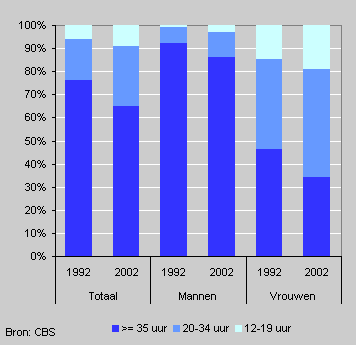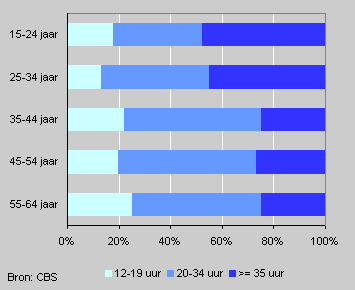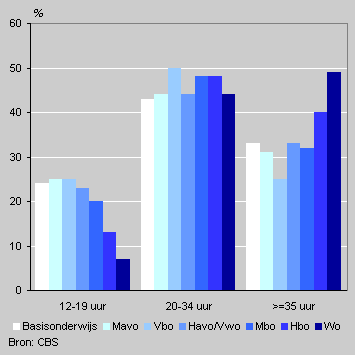Part-time work continues to rise

In 2002 35 percent of the employed labour force in the Netherlands had a part-time job. This is one and a half times the share ten years ago. Women, in particular ,are more likely to work part-time. In 2002 all working women above the age of 35 had a large part-time job.
Working hours, men and women

Two-thirds of working women work part-time
The percentage of the employed labour force working part-time increased from 24 percent in 1992 to 35 percent in 2002. The main factor in this increase was the higher number of women with a part-time job. In 1992 just over half of working women had a job of 12-34 hours a week. In 2002 this had risen to two-thirds.
Nine out of ten men work full-time
Most working men had a full-time job in 2002, just as ten years previously. Nearly nine out of ten men worked for at least 35 hours a week. The share with large part-time jobs, 20-34 hours a week, rose from 7 to 11 percent between 1992 and 2002.
Working hours of women, by age, 2002

Half of women over 35 have a large part-time job
Nearly half of women younger than 35 have a full-time job. After the age of 35 this changes, however. About one quarter of these older women have a full-time job. The number of women with a small part-time job rises slightly with age, but not by very much.
Working hours of women, by educational level, 2002

Higher educated women more often work full-time
A large part-time job is the most common form of work for women. This is true for all educational levels. The only exception is women with a university education. Nearly half of this group have full-time jobs. Women with a vocational college education, too, are more likely to work full-time than women with other educational levels.
Ingrid Beckers
Source: StatLine